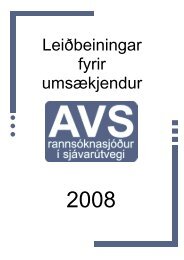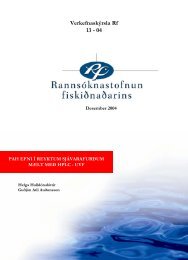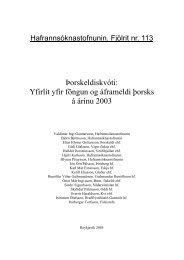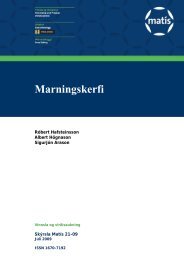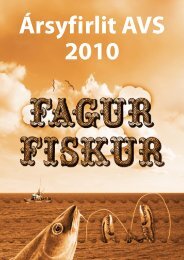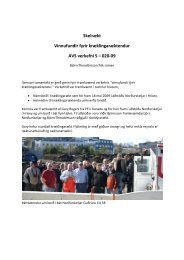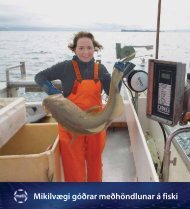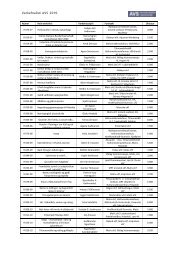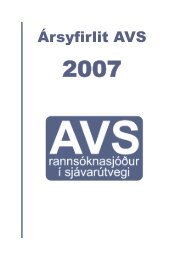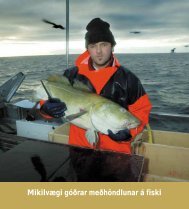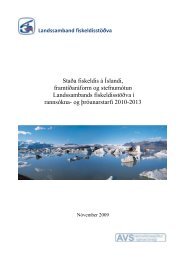CFD Modelling and Quality Forecasting for Cooling and ... - Matís
CFD Modelling and Quality Forecasting for Cooling and ... - Matís
CFD Modelling and Quality Forecasting for Cooling and ... - Matís
Create successful ePaper yourself
Turn your PDF publications into a flip-book with our unique Google optimized e-Paper software.
<strong>CFD</strong> <strong>Modelling</strong> <strong>and</strong> <strong>Quality</strong><strong>Forecasting</strong> <strong>for</strong> <strong>Cooling</strong><strong>and</strong> Storage of PelagicSpeciesLárus ÞorvaldssonBjörn MargeirssonSigurjón ArasonVinnsla og virðisaukningSkýrsla <strong>Matís</strong> 12-09Apríl 2009ISSN 1670-7192
Titill / TitleHöfundar / Authors<strong>CFD</strong> <strong>Modelling</strong> <strong>and</strong> <strong>Quality</strong> <strong>Forecasting</strong> <strong>for</strong> <strong>Cooling</strong> <strong>and</strong> Storage ofPelagic Species.Lárus Þorvaldsson, Björn Margeirsson, Sigurjón ArasonSkýrsla / Report no. 12‐09 Útgáfudagur / Date: Apríl 2009Verknr. / project no. 1851Styrktaraðilar / funding:Ágrip á íslensku:AVS rannsóknasjóður í sjávarútvegi , ByggðastofnunÍ verkefninu er tölvuvætt varma‐ og straumfræðilíkan afgeymslutönkum uppsjávarafla smíðað. Inntak líkansins ertímaháður umhverfishiti sem aftur skilar hitastigsdreifingu þeirrarblöndu uppsjávarafla og sjós sem geymd er í tönkunum. Það líkaner svo samtvinnað gæðaspálíkani sem segir til um þróunskemmdareinkenn<strong>and</strong>i efna svo sem TMA og NH 3 út frá þeirrihitastigssögu sem fæst úr varmafræðilíkaninu. Meginafraksturverkefnisins er þróun og beiting tækni sem gerir það mögulegt aðspá fyrir um skemmdaferla uppsjávarafla við gefnaumhverfishitasögu. Sú tækni gæti reynst gríðarlega notadrjúg ímeðhöndlun og vinnslu uppsjávarafla.Samstarfsfyrirtæki í verkefninu eru Síldarvinnslan, Skinney‐Þinganes og HB Gr<strong>and</strong>i.Lykilorð á íslensku:Summary in English:Tölvuvædd varma‐ og straumfræði, uppsjávarfiskur, gæðaspálíkanIn this project a thermodynamic model of storage tanks used <strong>for</strong>cooling <strong>and</strong> storage of pelagic species is constructed. The input <strong>for</strong>the model is transient ambient temperature, which gives thetemperature <strong>and</strong> velocity distribution in the mixture of pelagicspecies <strong>and</strong> seawater. This model is then coupled with a quality<strong>for</strong>ecast model, which predicts the development of spoilageindicators such as TMA <strong>and</strong> NH 3 from the temperature time serieswhich are retrieved from the thermodynamic model. The mainresult of the project was the development <strong>and</strong> application of atechnique which makes it possible to predict the spoilage ofpelagic species given only ambient temperature history. This couldprove immensely useful in the management <strong>and</strong> processing ofpelagic species.The following companies take part in this project: Síldarvinnslan,Skinney‐Þinganes <strong>and</strong> HB Gr<strong>and</strong>i.English keywords:Computational fluid dynamics, pelagic species, quality <strong>for</strong>ecasting© Copyright <strong>Matís</strong> ohf / Matis ‐ Food Research, Innovation & Safety
Table of Contents1 Introduction ..................................................................................................................................... 12 Methods <strong>and</strong> materials ................................................................................................................... 22.1 Model parameters ................................................................................................................... 22.2 Thermodynamic parameters ................................................................................................... 22.3 Meshing ................................................................................................................................... 32.4 Solver ....................................................................................................................................... 42.5 Boundary conditions ............................................................................................................... 42.6 Model validation ...................................................................................................................... 52.6.1 Measurements ................................................................................................................ 52.6.2 Analytical computation ................................................................................................... 52.7 Description of the <strong>for</strong>mation of TVN <strong>and</strong> NH 3 at a constant temperature ............................. 52.8 <strong>Quality</strong> <strong>for</strong>ecasting model ....................................................................................................... 73 Results ............................................................................................................................................. 83.1 Unsteady temperature load .................................................................................................... 83.2 Steady temperature load ...................................................................................................... 103.2.1 Comparison with analytical results ............................................................................... 123.3 Development of TMA <strong>and</strong> NH 3 .............................................................................................. 134 Conclusions <strong>and</strong> future work ......................................................................................................... 15Bibliography ........................................................................................................................................... 16
1 IntroductionIn this study storage tanks <strong>for</strong> pelagic species are thermodynamically modelled. The model is basedon four tanks located in Höfn, a town in SE‐Icel<strong>and</strong> <strong>and</strong> are owned <strong>and</strong> operated by Skinney‐Þinganes, a fisheries firm operated from the same location. The layout of the tanks can be seen inFigure 1.In the thermodynamic modelling a transient temperature load can be applied which then gives thecorresponding temperature <strong>and</strong> velocity distribution of the mixture of seawater <strong>and</strong> pelagic species.The thermodynamic model is then coupled with a quality <strong>for</strong>ecasting model where a set ofdifferential equations is constructed based on experimental results about the <strong>for</strong>mation of spoilageindicators such as TMA <strong>and</strong> NH 3 over time <strong>for</strong> a given temperature history.Figure 1: Setup of storage tanks <strong>for</strong> pelagic species in Höfn.1
2 Methods <strong>and</strong> materials2.1 Model parametersThe tanks are modelled two‐dimensionally since they are assumed to be fully axi‐symmetric. Eachtank can hold up to V=400m 3 <strong>and</strong> has an inner radius of r i = 5m <strong>and</strong> height of h t = 5.1m. The tankshave t t =15 cm thick concrete walls making the outer radius r o =5.15m. When modelling the use of iceslurry a certain part of the volume is modelled as solid ice. This is done since it is computationallyunfeasible to model each particle in the ice slurry.2.2 Thermodynamic parametersIn this study both transient temperature <strong>and</strong> a constant temperature of 15°C is applied to thesystem. The heat is conducted through a 15cm thick concrete wall. The concrete is assumed to havethe following thermodynamic properties: ρ =2300 kg/m 3 , c p = 880 J/kg/°C <strong>and</strong> k=0.63 W/m/K.The physical properties of seawater are retrieved from Seton Bennett (2008) assuming 3.5% salinity<strong>and</strong> are listed in Table 1.Table 1: Physical properties of seawaterT [°C] 0 10 20Ρ [kg/m 3 ] 1028.1 1026.96 1024.75c p [J/kg/K] 3985 3989 3993k [W/m/K] 0.563 0.5795 0.596µ [kg/m/s] 1.88∙10 ‐3 1.48∙10 ‐3 1.08∙10 ‐3The physical properties of pelagic species are assumed to be the same as white fish where the heatcapacity <strong>and</strong> conductivity are retrieved from J. Zueco (2003). (J. Zueco, 2003)Table 2: Physical properties of pelagic fishT [°C] 0 10 20Ρ [kg/m 3 ] 1070 1069.2 1067.7c p [J/kg/K] 4144 3683 3222k [W/m/K] 0.43 0.43 0.43µ [kg/m/s] ‐ ‐ ‐What is probably the largest assumption in this study is to consider the fish <strong>and</strong> seawater mixture asa homogeneous fluid. This is done in order to spare computational power <strong>and</strong> thereby speed up thecalculations. The physical parameters are weighted in relation to the mass percentage of eachmaterial.2
Table 3: Physical properties of fish <strong>and</strong> seawaterT [°C] 0 10 20Ρ [kg/m 3 ] 1053.24 1052.31 1050.49c p [J/kg/K] 4080 3805 3530k [W/m/K] 0.4832 0.4898 0.4964µ [kg/m/s] 1.88∙10 ‐3 1.48∙10 ‐3 1.08∙10 ‐3The physical parameters displayed in the tables above are interpolated linearly as a function oftemperature during the solution of the model.2.3 MeshingIn this unsteady free convection problem choosing a suitable time‐step <strong>and</strong> grid spacing is essential<strong>for</strong> a successful meshing strategy. The thickness of the boundary layer <strong>for</strong> a vertical flat plate in a freeconvection problem is determined from Holman (2002) as 3.93 Pr 0.952 Pr / Gr /which at x=0.5m gives a boundary layer thickness of δ=8.1 mm. The cell dimensions at the boundarylayer are there<strong>for</strong>e chosen as Δx=2 .0 mm.west sideaxi‐symmetricboundaryconditionFigure 2: Meshing of the model, where an axi‐symmetric boundary condition is used at the west side.Even though an implicit solution method is used to solve the time dependent problem the time stepis chosen such that the resulting Courant number is close to 1 such that3
Δ Δ Iterating the model gives a maximum velocity of u max =0.015m/s which results in a time stepofΔt 15s.Figure 3: Meshing of the boundary layer at the concrete wall.2.4 SolverThe problem is solved using Fluent, a general purpose <strong>CFD</strong> program based on the finite volumemethod. An unsteady, pressure based axi‐symmetric solver is used. Buoyancy is modelled using theBoussinesq approximation where the change in density is assumed to be a linear function oftemperature on an interval. A gravitational acceleration of 9.81 m/s 2 <strong>and</strong> an operating temperatureof 273.15 K are used in the Boussinesq approximation. The specific heat <strong>and</strong> thermal conductivity offish <strong>and</strong> seawater is interpolated linearly in the model using the parameters displayed in Table 3.2.5 Boundary conditionsThe surface of the fish‐water mixture is assumed to have a constant heat transfer coefficient of h=10W/m 2 /°C, which is a reasonable value <strong>for</strong> the heat transfer between water surface <strong>and</strong> still air(Williams, 1963). The bottom of the tank is adiabatic. In order to validate the model, a transienttemperature load is used as a boundary condition on the sides of the tank.4
2.6 Model validation2.6.1 MeasurementsFor experimental validation data collected by Ásgeir Gunnarsson, Ásgrímur Ingólfsson <strong>and</strong> Helgi ÖrnKristinsson, as a part of their final project from the Technical school in Reykjavík, was used. The datawas collected during five l<strong>and</strong>ings from the 22 nd of November until December 1 st 2007.Data was collected using eight temperature loggers, four at the side at 0.1, 1.1, 2.1 <strong>and</strong> 3.1 metersheight, <strong>and</strong> four at the centre at the same heights. Temperature was measured at one minuteintervals. Slurry ice was used in four cases, be<strong>for</strong>e, during <strong>and</strong> after l<strong>and</strong>ing. In one case no slurry icewas used. Data <strong>for</strong> ambient temperature was retrieved from the Icel<strong>and</strong>ic Meteorological Office <strong>for</strong>the weather station at Höfn during the same time period.2.6.2 Analytical computationIn a multilayered cylindrical system the heat flow is given by Holman (2002) 2 ln where T 1 is ambient temperature <strong>and</strong> T 0 is the temperature of the system. The convective heattransfer coefficient is denoted as h. The temperature at time step t i , can then be found from step t i‐1such that , , This gives the temperature development using a lumped heat capacity system. In such systems auni<strong>for</strong>m temperature distribution throughout the body is assumed. This is of course an idealizationsince <strong>for</strong> conduction to occur a temperature gradient must exist inside a material if heat is to beconducted into or out of the material. This assumption can then be used <strong>for</strong> comparison with thenumerical model.2.7 Description of the <strong>for</strong>mation of TVN <strong>and</strong> NH3 at a constant temperatureThe development of the spoilage indicator of total volatile nitrogen (TVN) <strong>for</strong> herring <strong>and</strong> bluewhiting has been measured by Dr. Eyjolf Langmyre at the Sildolje‐ og Sildemelindustriens Forskningsinstitutt(Magnússon, 2009). In that research the environment in a ship hull was simulated at aconstant temperature while the <strong>for</strong>mation of TMA <strong>and</strong> NH 3 were measured. The relationshipbetween temperature <strong>and</strong> the <strong>for</strong>mation of those compounds was described by constructingequations based on that in<strong>for</strong>mation.One of the results of that research was that the <strong>for</strong>mation of TMA in herring <strong>and</strong> blue whiting storedin sea can be modelled in the following way 1 where the coefficients a, b <strong>and</strong> c are displayed <strong>for</strong> different temperatures in Table 4 <strong>for</strong> herring <strong>and</strong>Table 5 <strong>for</strong> blue whiting, both in a bulk to simulate the conditions in a ship’s hull <strong>and</strong> in a single fish.The coefficient a denotes the initial amount of TMAO‐N.5
Table 4: Coefficients <strong>for</strong> the equation of TMA <strong>for</strong>mation in herring at three different temperaturesTMA in herring (bulk)TMA in herring (single)a b c a b c0°C 50 79 0.42 30 435 0.673.7°C 50 401 0.91 30 10630 1.519.5°C 50 22411 2.25 30 376823 3.08Table 5: Coefficients <strong>for</strong> the equation of TMA <strong>for</strong>mation in blue whiting at three different temperaturesTMA in blue whiting (bulk)TMA in blue whiting (single)a b c a b c0°C 80 32.29 0.448 40 12.64 0.5063.1°C 80 18.01 0.699 40 43.92 0.98610°C 80 58.34 1.575 40 59.17 1.764The <strong>for</strong>mation of NH 3 in the herring itself can be modelled such that where the coefficients a <strong>and</strong> b are displayed in Table 6 <strong>for</strong> herring <strong>and</strong> Table 7 <strong>for</strong> blue whiting.Table 6: Coefficients <strong>for</strong> the equation of NH 3 <strong>for</strong>mation in herring at three different temperaturesNH 3 in herring (bulk) NH 3 in herring (single)a b a b0°C 9.4 0.077 9.4 0.0813.7°C 9.4 0.113 9.4 0.1299.5°C 9.4 0.205 9.4 0.239Table 7: Coefficients <strong>for</strong> the equation of NH 3 <strong>for</strong>mation in blue whiting at three different temperaturesNH 3 in blue whiting (bulk) NH 3 in blue whiting (single)a b a b0°C 9 0.112 9 0.1443.1°C 9 0.186 9 0.17510°C 9 0.343 9 0.3376
2.8 <strong>Quality</strong> <strong>for</strong>ecasting modelThe equations above cannot be applied directly <strong>for</strong> temperature modelling as they are only valid <strong>for</strong>constant temperatures. By using a second order interpolation of the experimental data the followingsystem of equations is retrieved in the case of herring stored in a bulkTMA TMA 0 TMA 0 2 79.3687 0.8118 0.0019 30NH 3 NH 3 38.3817 0.29219 0.00056 TVN TMA NH 3<strong>and</strong> <strong>for</strong> blue whiting in a bulk the <strong>for</strong>mation of TVN as a function of temperature is given asTMA TMA 0 TMA 0 2 325.3523 2.4457 0.0046 80NH 3 NH 3 14.83958 0.08525 0.00011 TVN TMA NH 3The time dependent problem is then solved by solving the differential equations TMA TMA TMA2 NH 3 NH 3using numerical methods such as a fourth order Runge‐Kutta solver with temperature history as aninput.7
3 Results3.1 Unsteady temperature loadFor the unsteady temperature load the temperature history from the 21 st of November until the 1 stof December at Höfn was used. A layer of 0.5m thick ice is assumed to be on top of the fish <strong>and</strong>seawater mixture.Figure 4: Response of the system to an unsteady temperature load with iceFigure 4 shows the temperature response to that particular heat load. The lines labelled with ‘centre’are located at the axi‐symmetric boundary condition, at a height of 2.5m (middle) <strong>and</strong> 5m (top). Thelines labelled as ‘side’ are located at the boundary between the concrete wall <strong>and</strong> the fish‐seawatermixture at heights 0m (bottom), 2.5m (middle) <strong>and</strong> 5m (top). In all cases the temperature history isinterpolated linearly in three dimensions, height, radius <strong>and</strong> time. The points at the sides are thefastest to respond since the only thermal barrier between them <strong>and</strong> the heat load is a 15cm thickconcrete wall. When approaching the centre of the storage tank, the temperature distributionbecomes more uni<strong>for</strong>m, as the ice melts to compensate <strong>for</strong> increased heat in the system. Thetemperature at the centre of the tank remains at 0°C throughout the time period which wasobserved since the heat load is not enough to fully melt the ice which was put in the tank. Thetemperature where the ice is located stabilizes at 0°C rather than ‐1.9°C, which is the melting point<strong>for</strong> 3.5% brine, since the usage of flake ice is assumed, which is produced without salt. Thetemperature of the ice layer itself (Centre‐Top) steadily increases during the time period <strong>and</strong>approaches melting point at the end of it.8
Figure 5: Response of the system to an unsteady temperature load with no iceFigure 5 shows the temperature response to the heat load from the 22nd of November until the 1stof December without ice in the system. The system seems to respond slightly faster to temperatureload than without ice. Had the temperature load during that period been more, a sharper contrastwould probably have emerged between the system with ice <strong>and</strong> without ice.9
3.2 Steady temperature loadIn the problem with a steady temperature load an initial temperature of 0.3°C was used <strong>and</strong> atemperature load of 15°C applied.Figure 6: Temperature profile of the tank at 0.167h with a temperature load of 15°C applied.Figure 7: Temperature profile of the tank at 34.167h with a temperature load of 15°C applied.10
Figure 8: Temperature profile of the tank at 68.333h with a temperature load of 15°C applied.Figure 9: Temperature profile of the tank at 102.500h with a temperature load of 15°C applied.Figure 6‐Figure 9 show the development of the temperature profile in the system when a stabletemperature load of 15°C is applied. The temperature at points closest to the top <strong>and</strong> sides increases11
fastest, but the temperature change decreases in the deeper parts of the tank. The meantemperature (T m ) goes from 0.4°C to 4.6°C the 102.5 hours which are observed. The vertical‐gradientof the temperature seems to be dominant, as the Boussinesq approximation gives buoyancy towarmer water.A small boundary layer can also be seen at the boundary between the concrete wall <strong>and</strong> the fish <strong>and</strong>seawater mixture. In fact, the heat input there creates a circulation in the system, where warm fluidrises to the top, mixes with colder fluid, <strong>and</strong> falls to the bottom close to the axi‐symmetric boundaryat the centre of the tank.3.2.1 Comparison with analytical resultsFigure 10: Comparison of an analytic method using lumped heat capacity system <strong>and</strong> the numerical method applied inother calculations.Figure 10 shows the temperature development assuming a steady ambient temperature of 15°C <strong>and</strong>an initial temperature of fish <strong>and</strong> seawater of 0.3°C. Using the numerical method the averagetemperature of the fish‐seawater mixture is found over the temperature distribution in the entiretank displayed in Figure 6‐Figure 9. The temperature profiles seem to follow each other ratherclosely. However, the temperature found using the lumped heat capacity model seems to rise slightlyfaster than that using the numerical method. The reason <strong>for</strong> this is that in the analytical model theonly resistance <strong>for</strong> heat to be pumped into the system is the concrete wall, while the heat resistanceof the fish‐seawater mixture is not taken into account. The similarity of the two temperature profilescan be seen as an indication that the model is accurate, <strong>and</strong> increases confidence in the numericalsolution.12
3.3 Development of TMA <strong>and</strong> NH3Applying the temperature development shown <strong>for</strong> the numerical solution in Figure 10 where asteady temperature load of 15°C is applied can now be used to calculate the development of theTMA, NH 3 <strong>and</strong> TVN in the catch over time.Figure 11: Formation of TMA, NH3 <strong>and</strong> the resulting TVN <strong>for</strong> the average temperature in the tank applying a 15°C steadytemperature load.Assuming an initial amount of TMA 0 =10 mg/100g <strong>and</strong> (NH 3 ) 0 =20 mg/100g the graphs displayed inFigure 11 are generated. The raw material is assumed to be blue whiting.The temperature increases steadily during the four days which are examined, which results in a slowgeneration of TMA <strong>and</strong> NH 3 the first two days which then begins to increase rapidly <strong>and</strong> ends in atotal volatile nitrogen (TVN) content of approximately 92 mg/100g.The limits <strong>for</strong> production of high quality fish meal is usually around 100‐120mg/100g (Gunnarsson,1998). The final value of TVN <strong>for</strong> this given temperature history <strong>and</strong> initial values of TMA <strong>and</strong> NH 3 isslightly lower than this limit.13
Figure 12: Formation of TMA, NH3 <strong>and</strong> the resulting TVN <strong>for</strong> the temperature at the top of the tank closest to the wallwhere the same temperature load as in Figure 5 is applied.The model which has been developed in this project is very robust in the sense that it can be appliedto any point in a <strong>CFD</strong> model which can also be <strong>for</strong>ced with any temperature time series. This is doneby coupling Fluent, a general purpose <strong>CFD</strong> program, with MATLAB, a high per<strong>for</strong>mance language <strong>for</strong>technical computing.Figure 12 shows the versatility of the methodology which has been developed in this project. Thepoint at the top of the tank closest to the concrete wall is selected which is the most sensitive toexternal temperature load. The same transient temperature history as in Figure 5 is then applied tothe system <strong>for</strong> the first four days <strong>and</strong> the resulting spoilage indicators found using the quality<strong>for</strong>ecasting model.The influence of temperature on the spoilage indicators can clearly be seen on Figure 12 where a risefrom ‐1°C to 2°C on the second day greatly increases the <strong>for</strong>mation of TMA <strong>and</strong> NH 3 . The speed atwhich the TMA <strong>and</strong> NH 3 are generated then decreases again when the temperature gets lower. Sincethe ambient temperature is low during that time period the overall <strong>for</strong>mation of TVN is limited <strong>and</strong>well within the limits of high quality meal, where the final value at day 4 is approximately63mg/100g.14
4 Conclusions <strong>and</strong> future workThe main conclusion is that it is possible to model heat transfer in storage tanks <strong>for</strong> pelagic speciesusing computational fluid dynamics. Both steady <strong>and</strong> transient temperature load can be applied <strong>and</strong>the usage of flake ice can be taken into account by modelling a certain portion of the system in asolid phase. The numerical method gives similar results as the lumped heat capacity method, but isprobably more accurate since it takes into account heat transfer inside the medium, rather thanassuming it as a body with uni<strong>for</strong>m temperature distribution.During the time period, which the effects of a transient temperature load were examined, thetemperature fluctuated around 0°C. The result of this was a limited effect on the averagetemperature on the fish‐seawater mixture. However, the response of the system was evident,especially close to the concrete walls <strong>and</strong> the top layer of the mixture.The quality <strong>for</strong>ecast model was also successfully coupled into the thermodynamic model byintegrating Fluent with the technical computing language MATLAB. This way it is possible to directly<strong>for</strong>ecast the quality of the catch from ambient temperature only. This could prove immensely usefulin the management <strong>and</strong> processing of pelagic species.In future work the model could be improved in several ways. The assumption that the mixture of fish<strong>and</strong> seawater can be examined as a homogenous fluid is the most likely to introduce someinaccuracies. A more detailed solution to that problem would be very useful <strong>for</strong> further studiesutilizing computational fluid dynamics in the seafood industry.The model could be improved in several other ways. For example some methods could be developedto take the surface area of the flake ice into account. That would likely give a more realistic image ofthe effects of ice application <strong>and</strong> to which extent it stabilizes the temperature of the contents of thetanks. Another way, in which the model could be improved, would be to introduce air‐convectionoutside the walls of the tanks. This could be a good improvement on the model, <strong>and</strong> introduce theeffects of wind speed on temperature response.Experimental results on the <strong>for</strong>mation of TMA <strong>and</strong> NH 3 in pelagic species given some transienttemperature load could prove to be very useful in future research. This could improve the quality<strong>for</strong>ecasting model <strong>and</strong> hence further increase its reliability. (Seton Bennett, 2008) (Holman, 2002)AcknowledgementsThe project is funded by AVS which is a research <strong>and</strong> development fund of the Ministry of fisheries inIcel<strong>and</strong>. This project is also co‐funded by Byggðastofnun.15
BibliographyF. Alhama, C. G. (2002). Transient thermal behaviour of phase‐change processes in solid foods withvariable thermal properties. Journal of Food Engineering , 331‐336.Gunnarsson, J. W. (1998). Kæling uppsjávarafla ‐ notkun ísþykknis. Akureyri: Háskólinn á Akureyri.Holman, J. (2002). Heat Transfer. McGraw Hill.J. Zueco, F. A. (2003). Inverse determination of the specific heat of foods. Journal of Food Engineering, 347‐353.Magnússon, B. J. (2009). Bætt meðferð uppsjávarafla ‐ draft. Reykjavík: Háskóli Ísl<strong>and</strong>s.Seton Bennett, M. S. (2008). 2.7.9 Physical properties of sea water. Hämtat från Kaye & Laby Online:http://www.kayelaby.npl.co.uk/general_physics/2_7/2_7_9.html den 2 October 2008Williams, G. P. (1963). Heat Transfer Coefficients <strong>for</strong> Natural Water Surfaces. i C. f. Evaporation,General Assembly of Berkeley (ss. 203‐212). Gentbrugge: International Association of ScientificHydrology.16



